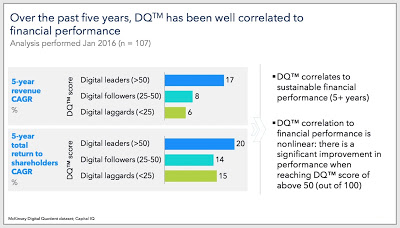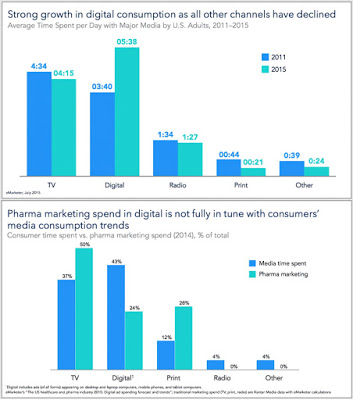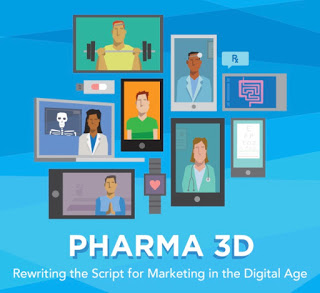The Wharton School, Google and McKinsey & Company have teamed up to write a new e-book entitled Pharma 3D: Rewriting the script for marketing in the digital age, which you can download here.
The book notes that while the world has experienced an “explosion of health-oriented digital activity,” there has been a simultaneous decline in pharma growth.
“This new reality has many implications for the pharmaceutical industry overall, particularly for commercial strategies,” say the authors.
“Historic mixes of advertising in traditional media combined with heavy salesforce coverage and ‘push’ messaging are insufficient,” say the authors. “While each of those tactics remains relevant, today’s commercial mix should reflect the fact that people are now viewing digital channels close to 50% of the time, and, even more importantly, that those people seek real engagement in regards to their care.”
Let’s examine those premises in more detail.
McKinsey research has found that companies with advanced digital capabilities grow revenues twice as fast as peers and deliver 25% greater total returns to shareholders annually. McKinsey consultants measured the “Digital Quotient” (DQTM) across industries and correlated that with financial performance to come up with the following chart:
 |
| Click on image for an enlarged view. |
The question is: How much more financial improvement can the pharma industry achieve merely by allocating more marketing resources to digital?
The authors make a case that pharma marketing spend is out of tune with consumers’ consumption of media:
 |
| Click on image for an enlarged view. |
“Print- and TV-advertising-based commercial strategies appear more and more out of sync with consumers’ and HCPs’ media consumption patterns and desired brand relationships, and hence less impactful than they once were,” note the authors.
This has been pointed out many times by others (read, for example, “Advertising Expert Says #Pharma Needs to Up Its Spending on Digital to Compliment Its TV Spend“). Pharma is even increasing its spend on TV (read, for example, “TV DTC Advertising Is Not Dead Yet!“). I can’t imagine pharma marketers doing that without getting a good return on the investment.
The problem with the top chart is that it includes the viewing habits of millennials mixed in with the baby boomer generation. The number of the former now is greater than the latter (see here). Pharma products — especially those advertised on TV — are primarily for baby boomers, not millennials. Consequently, the pharma marketing mix may be just right to reach the target audience.
The authors urge pharma marketers to learn from other industries such as Major League Baseball, especially with regard to “truly engaging with consumers and being responsive.” They propose the following tactics:
- To reach patients, pharma companies need to leverage broader engagement models through alternative digital channels (including wearables, online, and social media).
- Pharma companies can no longer rely solely on their relationships with physicians; they also need to engage with other influencers, like online communities and social

networks.
“The most successful pharma marketing organizations do three things really well,” say the authors. “They Discover the behaviors, beliefs, and needs of the people they are marketing to; they Design experiences relevant to the people they are marketing to; and they Deliver those experiences consistently, superbly, and efficiently. These phases are well known by experienced marketers, in pharma and elsewhere, but we refer to them as the 3Ds not only because they delineate the biggest areas of change for most companies, but also because we believe pharma needs to ‘think in 3D,’ adding depth and perspective as the industry moves from campaigns that talk at patients and physicians to solutions that listen to and engage with them.”
The remainder of the book is dedicated to “How-to”; i.e., how to “influence patient behaviors and decisions as they move through the CareFlow — the holistic cycle of detection, diagnosis, treatment, and recovery,” which is different than the traditional “Patient Journey” framework most pharma marketers are familiar with. I’m going to add the term to my “Glossary of Pharma Marketing Buzzwords.”
The authors, who can profit from more digital pharma marketing, hope that “most leaders of pharmaceutical companies can find new insights and approaches in [their] book, whether their organizations are already innovating their commercial strategies with more of a digital orientation, looking for ways to inspire their organizations to undertake that change, or investigating the role digital tools and channels should have.”









![6 Digital Tools at the Center of Healthcare Digitalization [INFOGRAPHIC]](http://ec2-54-175-84-28.compute-1.amazonaws.com/pharma-mkting.com/wp-content/uploads/2021/04/6DigitalTools_600px-100x70.jpg)




